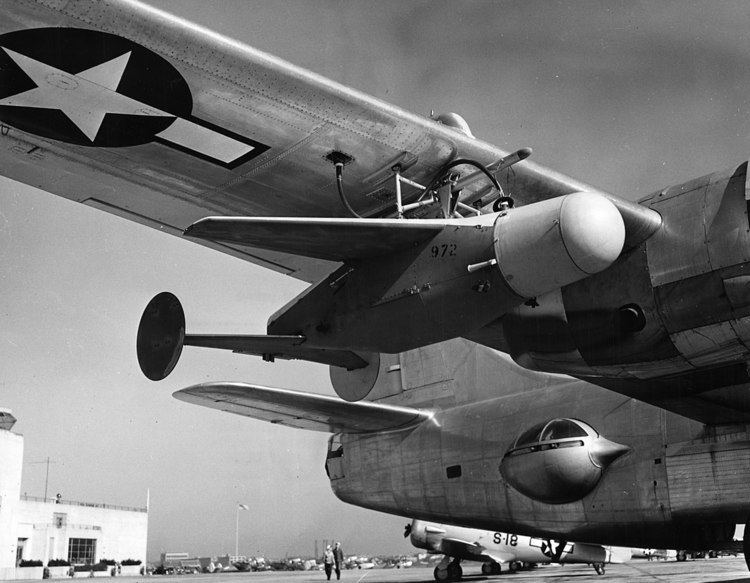Type Conventional | Place of origin United States | |
 | ||
In service 1942 (Bomb MK 57) - 1953 (ASM-N-2) Manufacturer National Bureau of Standards | ||
The ASM-N-2 Bat was a United States Navy World War II radar-guided glide bomb which was used in combat beginning in April 1944.
Contents
Background
In January 1941 RCA proposed a new TV-guided anti-shipping weapon called Dragon for which an operator would use the TV image sent from the nose of the weapon and operate aerodynamic controls during the weapon's fall. The National Bureau of Standards (NBS) would provide the airframe for use with a standard bomb, and was the same guidable ordnance airframe design used for the earlier, abortive Project Pigeon weapons program. The Pelican was a June 1942 modification to instead drop depth charges against submarines using semi-active radar homing. By mid-1943, the design was changed again to use a new active radar homing system from Western Electric with a 2,000-pound (907 kg) one short ton general-purpose (GP) bomb, the same basic "AN-M66" ordnance unit as used for the heavier USAAF VB-2 version of the Azon radio-controlled ordnance. This Pelican version entered testing in summer 1944 at Naval Air Station New York, where it hit its target ship in two out of four drops.
Development
The Bat was the production version which combined the original NBS airframe with a 1,000-pound (454 kg) AN-M65 GP bomb, the same basic ordnance that was used in the contemporary Azon guided munition, and the Pelican active radar system. Gyrostabilized with an autopilot supplied by Bendix Aviation, the steerable tail elevator was powered by small wind-driven generators. The Navy's Bureau of Ordnance in partnership with the Massachusetts Institute of Technology (MIT) supervised development and the NBS was in charge of the overall development. Flight tests were conducted at the Naval Air Ordnance Test Station at Chincoteague Island, Virginia. Hugh Latimer Dryden won the President's Certificate of Merit for the development of the Bat, which "was flight tested by a small unit based at Philadelphia against targets in New Jersey."
Deployment
The antiship variant of the Bat (SWOD, for "Special Weapons Ordnance Device", Mark 9 Modification 0) eventually saw combat service beginning in April 1945 off Borneo, dropped by Consolidated PB4Y Privateers (one bomb mounted under each wing) at altitudes of 15,000 to 25,000 feet (4,600 to 7,600 metres) at airspeeds of 140 to 210 kn (260 to 390 km/h). Several Japanese ships were sunk and the kaibokan Aguni was damaged from a range of 20 nmi (37 km), which is frequently miscredited as being sunk and as being a destroyer. Several Bats were also fitted with modified radar systems (SWOD Mark 9 Model 1) and dropped on Japanese-held bridges in Burma and other land-based targets. The Bat's pioneering radar guidance system was easily confused by radar land clutter, particularly against targets close to shore.
After the war, the naval designation ASM-N-2 was applied to the unit.
The Privateer was the primary launch platform for the Bat, but other aircraft were also modified to launch the weapon, including the Vought F4U Corsair, Curtiss SB2C Helldiver, and Grumman TBF Avenger. The primary post-World War II aircraft to carry the weapon was the P-2 Neptune.
Existing missiles
The original NBS test airframe of the Bat was renovated in 2001 to resemble the real missile and is currently on display at the museum of the National Institute of Standards and Technology, the successor to the earlier US National Bureau of Standards.
